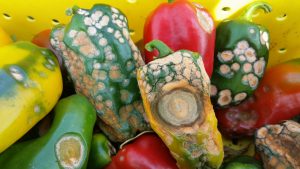- Late blight (US-23) was reported on tomato in Chester County in Southeastern PA this week. US-23 is active on both tomato and potato. All NJ tomato and potato growers are encouraged to scout their fields on a daily basis. Late blight has not been reported in NJ to date. If you suspect Late blight on your farm please contact your county Extension agent. To track the progress of Late blight in the US please visit USAblight.
- Cucurbit downy mildew (CDM) on cucumber continues to be reported throughout the region. All cucumber growers should add downy mildew specific products to their regular maintenance programs. CDM has also been reported cantaloupe and Butternut squash in PA. CDM has also been reported in pumpkin as far north as North Carolina. To track CDM movement in the US please visit the North Carolina State University’s CDM Forecasting Website.
- Bacterial canker and bacterial leaf spot in tomato are being reported. Bacterial leaf spot is also being reported in pepper.
- Pepper anthracnose has been reported in the past week.
- Dickeya dianthicola has been reported in 6 states and in 9 potato varieties to date including Dark Red Norland, Red Pontiac, Silverton, Yukon Gold, Kennebec, Norwis, Superior, Marcy, and Vivaldi.
- Surveying for Dickeya dianthicola in potato fields and irrigation sources in NJ is currently on-going. If you suspect Dickeya, please contact your county agent. The best method for controlling Dickeya dianthicola in your operation is to adopt a zero-tolerance policy.
- Want more information of what is going on around the mid-Atlantic region? Just click on the links to articles written by Extension personnel from PA, DE, VA, and WV on the right side of the page! You can also sign-up with and have information sent directly to you just like the NJ – Plant and Pest Advisory.
Vegetable Disease Update – 8/10/17
Controlling Pepper Anthracnose

Pepper Anthracnose
In recent years, pepper anthracnose caused by Colletotrichum spp. has become a significant problem on some farms in southern New Jersey.
Unlike in tomato, where symptoms are only present in mature (red) fruit, pepper anthracnose can infect pepper fruit at any growth stage. [Read more…]
Vegetable Disease Update – 7/26/17
- Cucurbit downy mildew (CDM) on cucumber continues to be reported throughout the region. All cucumber growers should add downy mildew specific products to their regular maintenance programs. CDM has been reported cantaloupe and Butternut squash in PA.
- Bacterial canker in tomato is being reported.
- Pepper anthracnose has been reported in the past week.
- There have been no new reports of Late blight on tomato or potato in our region in the past week.
- Dickeya dianthicola has been reported in 6 states and in 9 potato varieties to date including Dark Red Norland, Red Pontiac, Silverton, Yukon Gold, Kennebec, Norwis, Superior, Marcy, and Vivaldi.
- Surveying for Dickeya dianthicola in potato fields and irrigation sources in NJ is currently on-going. If you suspect Dickeya, please contact your county agent. The best method for controlling Dickeya dianthicola in your operation is to adopt a zero-tolerance policy.
Vegetable Disease Update – 7/19/17
- Cucurbit downy mildew (CDM) has been confirmed on cucumber in northern and southern New Jersey. All cucumber growers should consider adding downy mildew specific products to their regular maintenance programs. CDM has been reported cantaloupe and Butternut squash in PA.
- Basil downy mildew has been reported in New Jersey.
- There have been no new reports of Late blight on tomato or potato in our region in the past week.
- Dickeya dianthicola has been reported in 6 states and in 9 potato varieties to date including Dark Red Norland, Red Pontiac, Silverton, Yukon Gold, Kennebec, Norwis, Superior, Marcy, and Vivaldi.
- Surveying for Dickeya dianthicola in potato fields and irrigation sources in NJ is currently on-going. If you suspect Dickeya, please contact your county agent. The best method for controlling Dickeya dianthicola in your operation is to adopt a zero-tolerance policy.
Cucurbit Downy Mildew ALERT – 7/6/17
Cucurbit downy mildew was confirmed on cucumber in northern New Jersey (Warren County) today near Allamuchy. This is the third report of CDM on cucumber in New Jersey this growing season. All cucumber growers in NJ are encouraged to add downy mildew specific fungicides to their weekly maintenance spray programs. All growers should scout cucumber plantings as well as all other cucurbit crops for symptoms. CDM has also been reported on cucumber in MD, DE, and PA. To track the progress of cucurbit downy mildew in the US through the CDMpipe website through NCSU please click here.
Vegetable Disease Update – 7/6/17
- Cucurbit downy mildew has been confirmed on cucumber in 2 counties in southern New Jersey. All cucumber growers should consider adding downy mildew specific products to their regular maintenance programs.
- Basil downy mildew has been reported in central New Jersey.
- Late blight has been reported in areas outside the mid-Atlantic region this past week. There have been no new reports of Late blight on tomato or potato in our region in the past week.
- Dickeya dianthicola has been found in potato in Australia.
- Surveying for Dickeya dianthicola in potato fields and irrigation sources in NJ is currently on-going. If you suspect Dickeya, please contact your county agent. The best method for controlling Dickeya dianthicola in your operation is to adopt a zero-tolerance policy.
